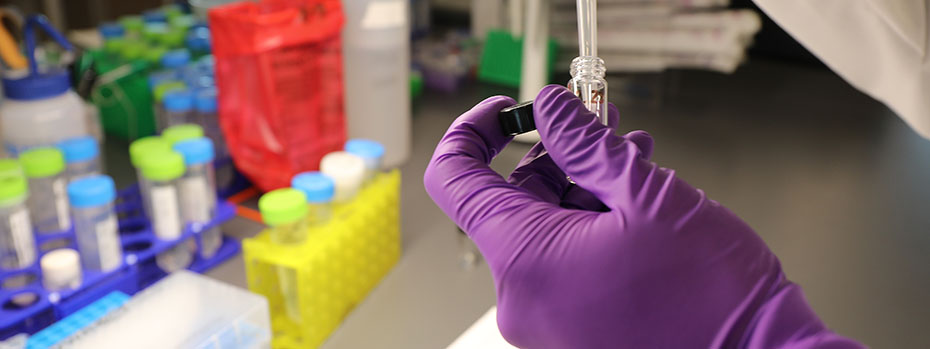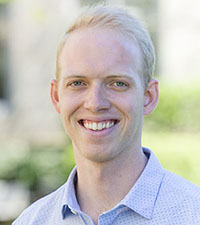Alumni Impact

As biomedical engineers, our goals are to improve human health and to find innovative solutions to persistent patient needs. On this page you’ll meet five of our biomedical engineering alumni whose work as Ph.D. students led to discoveries that will change health care for the better.
Julia Leach, Ph.D. 2015
Director of Translational Research, Cognito

Julia Leach felt a strong desire to return to her Oregonian roots as she neared completion of her bachelor's degrees in psychology and engineering at Gonzaga University. As she explored doctoral research opportunities, OHSU’s Biomedical Engineering graduate program felt like an ideal fit to fuse her interests in technology and neuroscience. “I pivoted to engineering in my third year of undergrad, despite being only one class shy of completing my pre-med requirements, as I realized that I wanted to be more involved in developing novel technologies to help people with neurodegenerative diseases like Alzheimer's and Parkinson’s. The groups at OHSU led by Dr. Tamara Hayes (Oregon Center for Aging & Technology) and Dr. Fay Horak (Balance Disorders Laboratory) were using engineering approaches to identify early changes associated with neurodegenerative diseases and identify early-stage disease markers, promote earlier intervention, and potentially introduce new therapies to impact cognitive and functional decline. I found this to be fascinating and wanted ‘in’,” said Dr. Leach.
Dr. Leach was accepted into the graduate program and was co-mentored by Dr. Hayes and Dr. Horak. “This was a great experience for me, as I was able to cross over between the two groups and learn more about engineering approaches as well as the neuroscience behind these diseases.” The diverse team of experts along with support from multiple grants including an NIH/NIA Neuroscience of Aging trainee award provided Dr. Leach an unparalleled training experience. “There was a great team dynamic as we utilized expertise from both groups to advance the research. These two mentors (and later Dr. Jeff Kaye who stepped in following the untimely passing of Dr. Hayes) coupled with the rigorous Biomedical Engineering graduate program provided an amazing environment for learning and growth- one that was both challenging and supportive.”
Dr. Leach defended her PhD in 2015, then moved to Italy for a postdoctoral fellowship at the University of Bologna where she continued to leverage novel technologies to study the relationship between cognitive and functional decline in aging populations. In 2018 she transitioned to industry, a decision that was based on her desire to begin applying her work to solutions that could more directly impact patients. She joined Synergic Medical Technologies, a Eugene, OR-based medical device start-up as a Scientist, developing non-invasive neuromodulation techniques to alter brain activity, restore brain functions, and relieve Parkinson’s disease symptoms. In 2021, Cognito Therapeutics, a pivotal-stage company based in Cambridge, MA, recruited her as a Senior Scientist. “I was very excited about the opportunity to join Cognito, where we’re developing safe, non-invasive treatments to improve brain health and well-being. Cognito’s Spectris™ therapy is disease-agnostic by design, using non-invasive sensory stimulation to evoke gamma oscillations in the brain, inducing gene and protein expressions critical to the preservation of cognition, daily function, and brain structure. We’re currently running a pivotal trial in mild-to-moderate Alzheimer’s disease, where our evidence to date suggests we’re targeting abnormal neural network dynamics, synaptic dysfunction, neuronal loss, and neuroinflammation. Our investigational treatment holds promise across the neurodegenerative spectrum and beyond, so should we demonstrate efficacy in slowing the decline of Alzheimer’s… well, I’ll have trouble containing my excitement! I’ve dedicated my career thus far to the research and development of innovative, non-invasive, and non-pharmacological therapies targeting the vast and debilitating unmet needs of those enduring neurodegeneration. I have increased hope as treatment options evolve, expand, and become far more attainable and patient-centric, prioritizing daily function and life quality over other, less meaningful outcomes. It would be a great privilege to positively impact quality of life for those enduring the direct or indirect consequences of neurodegeneration.”
Although Dr. Leach was recognized by Business Insider as one of the Top 30 Under 40 Rising Leaders Forging the Future in Healthcare in 2023 and was promoted to Director of Translational Research at Cognito, she is most proud of the path that she forged for herself. “There were many obstacles along the way… and many “no’s,” even from those I had expected encouragement from. If there’s some guidance I’d share with new trainees… it’s that perseverance, resilience, and humility is necessary because science isn’t for the faint of heart – it requires constant learning, adaptation, persistence, and courage. You won’t know everything, and that’s okay. Don’t pretend to. Lean on your peers and colleagues – a collaborative spirit and diverse perspectives are essential for success. Don’t be afraid to fail, because you will – it’s inevitable, especially when innovating. It’s what you make of it that matters most, so keep growing, advancing, and refining your knowledge and skillset. Discoveries will come when you believe in yourself, push yourself, and devote yourself to the service of others – a greater purpose, something bigger. That’s what anchors, motivates and inspires me!”
Michelle Berny-Lang, Ph.D. 2010
Program Director, National Cancer Institute, NIH

Michelle Berny-Lang’s career path to becoming a Program Director at the National Cancer Institute (NCI) within the NIH has been shaped by a combination of curiosity, mentorship, and a deep commitment to biomedical research. Originally from Oregon, Michelle earned a Bachelor’s degree in Bioengineering at Oregon State University, with plans to continue her graduate studies outside the state. However, a pivotal conversation with Dr. Owen McCarty, her future graduate mentor at OHSU, led her to reconsider. Dr. McCarty’s enthusiasm and vision for applying engineering approaches to healthcare challenges convinced her that OHSU was the best place to continue her bioengineering training.
“I couldn’t be happier with my decision,” Michelle says, reflecting on her time at OHSU. “It was an excellent environment to grow and learn, both as an engineer and in close proximity to the work of OHSU clinicians.” At OHSU, Michelle focused her research on the mechanisms of blood clotting, particularly how these processes change in the body when blood is flowing. Her work examined roles of a blood cell, the platelet, and the coagulation protein, thrombin.
Michelle’s experience at OHSU went beyond research alone. “I had the opportunity to develop critical research skills and also gain experience in mentoring, project management, and lab operations. These skills would prove invaluable later in my career,” she explains. Her time in the small (at that time) and collaborative lab environment allowed her to refine not only her technical expertise but also her ability to manage projects, communicate effectively, and navigate the complexities of working across disciplines. “Developing into a researcher who can think critically, communicate clearly, and integrate inputs from various scientific fields was crucial. But just as important were the soft skills—collaborating across diverse expertise and personalities, framing research plans persuasively, and managing teams. These skills have shaped my career path,” Michelle notes.
After completing her graduate studies, Michelle took on a postdoctoral position at Harvard Medical School and Boston Children’s Hospital, where she worked on clinical research involving platelets and their role in diseases such as sickle cell anemia and acute coronary syndrome. “While I loved the hands-on research, I also had broad scientific interests and wanted to contribute to science from a different perspective,” she says. This desire for a broader impact led Michelle to pivot her career toward the National Institutes of Health (NIH), the largest public funder of biomedical research in the world. In 2013, after a series of informational interviews, Michelle was hired as a program director at the National Cancer Institute of NIH, where she helps bridge the gap between technology development and cancer research. “Once I learned about the NIH’s mission to advance research and improve health, I was hooked. I wanted to be a part of it,” she reflects. At NCI, Michelle plays a key role in identifying research needs, creating resources, and developing programs to support cancer research.
One of Michelle’s proudest achievements at NCI is her involvement in launching a collaboration with the Department of Veterans Affairs (VA) to leverage healthcare data for research. “NCI recognized the vast amounts of data being generated throughout cancer research and care,” she explains. “We realized that we needed more individuals with the right skills to extract valuable insights from this data.” In response, they launched a data science training program to bring in postdocs with quantitative expertise and immerse them in the VA healthcare environment to learn the data and conduct research. Since the program’s inception in 2015, over 60 fellows have participated, and Michelle is proud of their subsequent success, whether in academic research or government roles. “I’m honored to have played a part in helping these fellows advance in their careers,” she says. “Even if my role in their journeys is small, knowing we’ve created a program that contributes to their success is incredibly rewarding.”
Looking back on her career, Michelle recognizes the profound impact that mentors have had at every stage. “I’m so grateful for the people who took a chance on me,” she says. A bioengineering professor at OSU invited her to her first research opportunity which sparked her interest, while her graduate mentor, Dr. McCarty, helped her develop into a researcher and consistently sought out opportunities for her growth. “In the government, the leadership and my colleagues have been invaluable in guiding me through new challenges,” Michelle adds.
Michelle also emphasizes the importance of adaptability in her career noting “Flexibility has been key to my career. Being open to different projects and responsibilities has allowed me to work with new colleagues, learn new skills, and ultimately expand my expertise,” Her ability to apply engineering principles to various scientific fields has been a driving factor in her success. Michelle suggests those starting their careers embrace diverse experiences, even if they don’t align perfectly with immediate goals. Unexpected opportunities can enrich your career and provide the foundation for future success.
“The exciting thing about my role is that it’s always evolving as science moves forward. It keeps me on my toes, and I’m honored to be part of NIH and continue contributing to new scientific developments,” Michelle says.
Erik Tucker, Ph.D. 2009
President & CEO, Aronora, Inc.

Erik Tucker’s search for the holy grail began in graduate school, working in an OHSU biomedical engineering lab on the problem of how to safely break up blood clots. Now, as the chief executive of OHSU startup Aronora, Inc., he’s closer and closer to sharing his discovery with the world.
Blood clots cause heart attack, stroke and lung blockages that can be fatal. However, existing therapies come with a serious side effect: increased risk of severe bleeding.
Tucker and OHSU professor Andras Gruber discovered a way to target certain coagulation proteins in the blood, dissolving blood clots without increasing the risk of dangerous bleeding. They founded Aronora as a way to bring their academic lab discoveries to patients in need.
“We're working on what's considered the holy grail of anti-thrombotic therapy,” Tucker said. “This is a new generation of blood thinners and clot busters that don’t increase the risk of bleeding. We can save lives with these new drugs.”
The eight-person Portland-based company now has five medicines in various stages of development. Three are in Phase 2 clinical trials and two are in pre-clinical studies.
Tucker, who was named a 2022 Fellow of the National Academy of Inventors, holds more than 90 U.S. and international patents. After graduating in 2001 with a degree in biochemistry from the University of Oregon, he came to OHSU in 2004 with the goal of helping people protect their health. He chose biomedical engineering as the best way to do that.
“Biomedical engineering has a strong focus on turning scientific discoveries into useful drugs and devices,” he said.
Connor Barth, Ph.D. 2018
Co-founder & CEO, Trace Biosciences

Connor Barth chose OHSU for his Ph.D. because he was intrigued by the biomedical engineering department’s work using fluorescent dyes to light up nerves during surgery. Little did he know he would later co-found a company to bring that technology to operating rooms.
The need is real; surgeons who can better see delicate nerves are able to avoid them, reducing the chance of injury.
“I never wanted to just be a scientist, discovering new things for discovery’s sake. I wanted to help people,” he said. “I was drawn to the work in Summer Gibbs’ lab because it had a strong translational focus. It’s meant for patients.”
Gibbs served as Barth’s faculty mentor during his studies. Barth, Gibbs and postdoctoral fellow Lei Wang (now a research assistant professor), co-founded Trace Biosciences in 2019 when the fluorescent dyes were ready to move from the Gibbs Lab to the newly formed OHSU startup for further development and commercialization.
Since then, Trace Biosciences, under Barth's direction, has secured millions of dollars in grants and investments to bring the technology into the operating room.
Roughly 25 million patients worldwide each year have nerve damage from surgery, causing pain, loss of function and expensive follow-up care.
Trace Biosciences is now a seven-person company, with two products under development and plans to begin clinical trials in 2024.
Worapol Ngamcherdtrakul, Ph.D. 2015
Principal Scientist/COO, PDX Pharmaceuticals, Inc.

Worapol Ngamcherdtrakul believes scientists and business executives have more in common than you might think.
“Both are problem solvers. New problems and tasks are coming your way all the time, and you rarely stick to one routine. You have to analyze available information or data, and strategize next steps accordingly,” he said. “That’s what I like about being a scientist and it’s a common element in being an entrepreneur.”
Ngamcherdtrakul, who earned a Ph.D. in biomedical engineering from OHSU in 2015, serves as principal scientist and chief operating officer at PDX Pharmaceuticals. The company was founded in 2010 by OHSU faculty member Wassana Yantasee. Ngamcherdtrakul was so intrigued by Yantasee’s work in nanomedicine that he came to Oregon all the way from Thailand to study in her lab.
His doctoral research was instrumental in developing a tiny particle made of silica that can deliver a molecule known as siRNA, or small interfering RNA, to breast tumors. It’s an effective treatment for cancer, but degrades quickly in the bloodstream. The company’s nanoparticle delivery system solves that problem.
Today, at PDX Pharmaceuticals, he continues to work on that system as a way to deliver other drugs, vaccines and immunotherapies to treat multiple types of cancer and infectious diseases. The startup has raised more than $13 million in financing and has six lead drug candidates in the pipeline. Two are nearly ready for clinical trials.
“Working on the very important problem of bettering human health is quite inspiring, and that’s what motivated me to do what I’m doing,” he said.
Join our program
Your research career starts here.
Learn more
Stay connected
Join the OHSU Biomedical Engineering Alumni group on LinkedIn.
OHSU Innovates
Learn how OHSU supports researchers seeking commercial markets for their scientific discoveries.